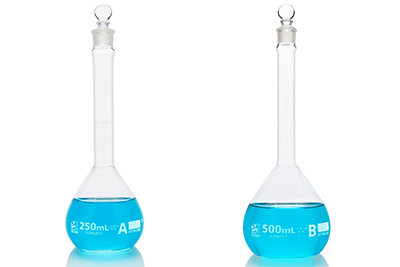

Cookies make our site work properly and securely. By using this website, you agree to our policy and will get the best user experience with brand enriched content & relevant products and services.


As a busy lab professional, you need to have confidence that the glassware in your lab is reliable and of high quality. You don’t have time to worry about how your glassware will perform in measurement settings—you need the peace of mind that it can compete with the best products on the market.
Luckily, product manufacturers have made it easy to differentiate among glassware and determine which types of glass are appropriate for which lab environment by creating a quality classification system. This system separates glassware into two categories according to the level of accuracy in measuring volume: Class A and Class B.
Here’s what you need to know about the difference between each glassware class, and why it matters.
In chemistry, there are almost always no absolutes. However, when you’re seeking the highest volumetric precision available, reach for Class A glassware, which is considered to be precision-grade.
At Globe Scientific, our Class A glassware is marked with an “A” that indicates that it meets Class A standardized tolerance requirements as set forth by the American Society for Testing and Materials (ASTM)— tolerance meaning the amount that the product is allowed to deviate from its stated value. For example, a Class A 10mL volumetric flask has a tolerance of ±0.02mL, meaning that a sample of solution that is filled to exactly the 10mL mark may actually contain 9.98mL or 10.02 mL of fluid, but it is calibrated to only deviate within that given range.
Our Class A glassware also comes with a calibration certificate, which confirms that the product has been specifically tested for compliance with the assigned standard, and it is traceable back to this calibration event. This reassurance is crucial when you are collecting data, and high accuracy is required.
Class B glassware is generally considered to be more economical than Class A, and it is appropriate for situations of general lab use or educational purposes. The tolerance of Class B glassware is twice that of Class A. Using the example above, the tolerance of a Class B volumetric flask is ±0.04mL, meaning that the liquid it contains could range from 9.96mL to 10.04mL when filled precisely to the inscribed 10mL mark. Class B glassware can be useful if you have a high-volume process where crude estimates are allowable or if you are mixing solutions or transporting liquids.
Designed to meet the needs of the most demanding laboratory professionals, Globe GlassTM laboratory glassware sets the standard for performance and packaging in the glassware marketplace. Top quality borosilicate glass delivers outstanding strength, durability, and chemical resistance. Superior GlassGuardTM packaging has been engineered to ensure that Globe Glass™ products arrive at their destination intact and ready for use each and every time. Globe Glass™ beakers, Erlenmeyer flasks, volumetric flasks, graduated cylinders, and media bottles are offered in sizes most commonly used in laboratories everywhere. Check out our laboratory glassware line, today!